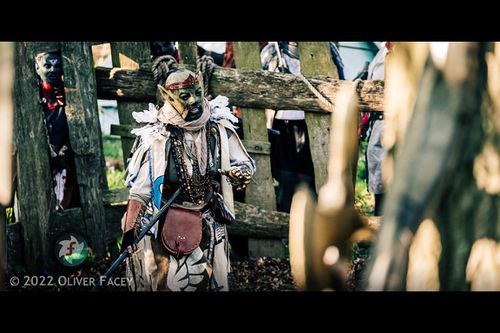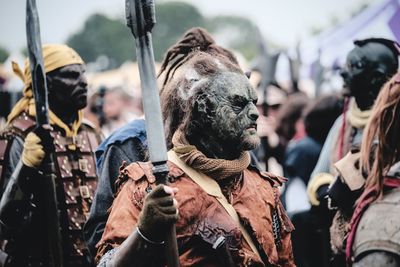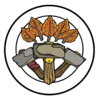Imperial Orcs military concerns

Overview
At present there are three Imperial Orc armies; two of them roughly fifty percent larger than a standard Imperial army. Plans have been mooted a few times for splitting the Winter Sun and the Summer Storm to try create three armies, but the two armies were created when the orcs joined the Empire and have a long and noted history that few orcs are willing to give up - most take great pride in their army's achievements. Imperial Orcs are also aware that much of their political unity arises from the tight-knit nature of the armies and the legions attached to them and they are keen to prevent their loyalties being divided amongst too many armies and generals. Ultimately though the biggest consideration has simply been the practical costs involved in reforming the orc armies - the costs involved, the loss of efficiency as the armies are reorganized, and the time in barracks required to complete the change.
It is commonly assumed that the orc love of battle would cause them to throw themselves into the thickest fighting without a care for their own lives. Such behaviour is sometimes observed of the forces of barbarian nations; their warriors are often overcome by battle-lust. However the Imperial Orcs are painfully aware of their limited numbers and the need to preserve every life to ensure that future generations of their nation prospers. The burden of this responsibility tends to fall squarely on their military leaders - the generals who command the armies and those who lead the heroes at Anvil. Life is precious - an orc has but one life to make their mark.
Although orcs strive to preserve themselves and their legion, cowardice is one of the most heinous of crimes – an act of self-preservation which threatens others. By contrast, the truest form of courage an orc can show is to give their life so that the legion can survive: it is difficult to become an ancestor if you fall before old age, and as this is the very zenith of orcish achievement, it takes a truly selfless orc to make the hardest sacrifice. Tales are told of such heroes, but they are always tinged with regret at the waste of life. Every orc that falls in battle is seen as a cause for sorrow: an early death prevents them from becoming an ancestor as well as diminishing the strength of the legions.
The barbarian orcs once harboured a particular hatred for the Imperial Orcs, often singling them out on the battlefield where possible. Some claim this hatred goes back to the time of the uprising when the barbarians refused to aid Thrace and his kin and slaughtered any orcs who made their way over the border. In recent times however, this old hatred appears to have abated to be replaced by something akin to a grudging respect. There is a great deal of speculation as to why this may be the case, but no concrete conclusion has been reached.
The Legion
The legions, tight-knit groups of Imperial Orcs who live together and fight together, are the backbone of the Imperial Orc armies. Before the arrival of the septs most Imperial Orcs were (or still are) a member of one of these countless different units of tight-knit soldiers. Each legion has its own identity but most are organized along military lines, and are an official part of one of the three Imperial Orc armies. In practice the legions are a cross between a regiment and an informal family group. Although not all the members of a legion are warriors, or even members of an army, the camaraderie and mindset of the career soldier tends to permeate throughout a legion.
Each orc legion chooses its own name and symbols but most can also be identified by their favoured fighting style. One legion may have a bias for plate armour and pole-weapons, while another favours sword and shield. Warriors are usually expected to have at least a basic mastery of their legion's favoured style. Each legion is fiercely proud of its identity in battle, and a healthy, good-natured rivalry exists between legions with regard to tactics and combat style. This rivalry is put aside on the battlefield, and warlords are careful to ensure that it never undermines loyalty and service to the Empire; the place for combat between members of rival legions is the fighting pit, not the battlefield.
Banners and standards are particularly important to Imperial Orcs. Legion camps are often decorated with banners displaying legion symbols, as orcs find it reassuring to be surrounded by images that reinforce their group identity. Many bear an image of the horse as a symbol of the Empire alongside specific legion markings and colours. Imperial Orcs differentiate between banners, which are general symbols of legion identity, and a legion standard. Many legions have a legion standard, which is a symbol of the legion's pride. Trophies from particularly notable legion members or items of exceptional worth that once belonged to someone in the legion are often added to a legion standard.
Legions chose their own commanders, called warlords, with individuals chosen for their ability to provide clear effective leadership in battle, according to the traditions of the individual legion. Orcs expect their leaders to be inspirational as well as astute so the majority of warlords are powerful warriors who lead from the front. Those who lead by cunning alone need to be particularly smart and their legions are often small but very tight-knit. Warlords appoint members of the legion to a chain of command beneath them, so that if they fall in battle they can be quickly replaced – the life of the legion is always more valuable than the life of any individual.
Most legions have a clear chain of command with harsh punishments for disloyalty or disobedience. Imperial Orcs usually have little sympathy for individuals who refuse to follow orders. In battle, those who find themselves at odds with a legion’s leadership face summary court-martial; at other times they are usually expelled from the legion. In such cases a group of orcs usually form their own rival legion, while an individual must attempt to join another legion or face existence alone.
Imperial Armies
The Imperial Orcs field three Imperial armies; the Winter Sun, the Summer Storm, and the Autumn Hammers. Although Imperial Orcs are increasingly putting down roots in Skarsind, the armies remain an important source of identity and a reminder of their people's history. Founded in the aftermath of the revolt, membership of the armies was initially influenced by considerations of geography. Today, however, the third generation of orcs attach themselves to the army with which they feel the greater philosophical attraction, rather than basing their decision on which army their grandparents' legion belonged to.
Orcs do not generally wear a uniform symbol of the army they belong to, but some may add a white sun or a red lightning bolt. Since each army is made up of many different legions it has become common to refer to the armies collectively as "the legions" and in recent times Imperial Orcs at Anvil have taken to describe the Winter Sun and Summer Storm as the First and Second Legion respectively.
The Winter Sun
This army began with a core of orcs who had been slaves in Varushka, Temeschwar, and Wintermark. Vicious fighting against the Varushkan armies had decimated the numbers of the freed slaves in that nation, and harsh winters had contributed further to the death toll. After the revolt, their numbers were supplemented with orcs who had been enslaved by the Highborn. The first magicians among the Imperial Orcs belonged to this army; they found it easiest to absorb the teachings of the Varushkan and Wintermark tutors the Urizen mages arranged for them. The hard core of the army were made up of many who had known Thrace and the other founders of the revolt personally, and they continued to develop the vision of freedom that had first spurred them to escape the mines.
Today the Winter Sun is the more politically active of the two Imperial Orc armies, but it is also the army most likely to use magic in pursuit of their goals. They garner favours, both through military aid and careful use of their magical resources. More warcasters and oathwrights fight under the banners of the Winter Sun than the Summer Storm, and they have more preachers.
The Winter Sun is a large army with a history of fighting in difficult terrain. Following a ritual performed at the Autumn Equinox 381YE, the soldiers and associated of the Winter Sun experienced powerful visions of the many generations of ancestors who had lived as Imperial slaves. Embracing these visions, the general, Bloodcrow Morg'ur, helped to change the direction of the army towards fighting for freedom.
The first Imperial Orc general leads the Winter Sun, and is appointed (or re-appointed) at the Winter Solstice.
The Summer Storm
This army was formed from orcs who had originally been slaves in Dawn, the Marches, and the southern and eastern cities of The League. Their uprising had taken part in the rich heartlands of the Empire, and they did not need to deal with the harsh northern climate that troubled orcs in Varushka, Wintermark, and Highguard. They also tended to be better equipped; they were more able to loot weapons and armour, and were in a good position to deal with the 'war profiteers' from the Brass Coast and League cities. Perhaps just as importantly, the southern slaves were often surprisingly more well-versed in tactics, subterfuge, and trade than their northern cousins - many more of them had spent their time as bodyguards, bouncers, or gladiators than in the north.
Today the Summer Storm pride themselves on their military acumen. They are the hammer of the Imperial Orcs, well armed and armoured, versed in strategy and tactics, and supported by cunning bonesetters and thief-takers. They tend to be richer in terms of wealth and crafted items, and the first smiths and artisans were part of the Summer Storm.
Shortly before the Summer solstice 380YE, while fighting the Jotun in the Mournwold, the soldiers of the Summer Storm experienced a profound moment of connection with a Jotun ancestor, Sjöfn of the Bittenblade. Apparently an ancient Jotun who appears unconcerned by the nature of the Imperial Orcs, her voice encourages them to fight heroically, gloriously, and revel in the clash of steel on the battlefield. (OOC Note: Any Imperial Orc who might have been present during that campaign can hear this ancestor if they wish; she encourages them to take actions that are in line with the five things of the Jotun.)
The Summer Sun is a large army, known for its ruthless commitment to the arts of war, and its indomitable fighting spirit.
The second Imperial Orc general leads the Summer Storm, and is appointed (or re-appointed) at the Summer Solstice.
The Autumn Hammers
The Autumn Hammers was raised from the Ethengraw sept after the Black Forge was constructed in Skarsind. The motion to raise the army was passed by the Imperial Senate during the Autumn Equinox 385YE after the sept joined the Imperial Orcs. The army benefited from Hammers of Fury and finished raising in time for the general to be elected for the first time at the Spring Equinox 386YE.
The third Imperial Orc general leads the Autumn Hammers, and is appointed (or re-appointed) at the Autumn Equinox.
Supply
The Imperial Orcs have long faced a crucial challenge posed by their relatively small population. For a long time they were able to maintain two large Imperial armies in the field - but only just, and only because so many of their people were members of the legions. Until very recently it was impossible for them to raise a new army, and if one of their existing armies were wiped out it was certain that it would be difficult for them to replace it. Imperial Orc generals learned to be careful about how they deployed their forces - preserving lives where they could - to keep the nation vital.
Gaining Skarsind gave the Imperial Orcs a homeland but did nothing to remedy the limitations of their sparse numbers. When the Highborn liberated Reikos, they were able to supply a fourth army as much because the people of Reikos stood ready to be part of that army as because of the wealth and prosperity the territory eventually regained. The few original inhabitants of Skarsind who still dwell there are Wintermark humans - so there is no indigenous population to swell their ranks.
This situation was somewhat mitigated by the raid on Beoraidh at the beginning of 383YE. With the support of the Winter Sun, a significant Imperial force launched a surprise attack on the Grendel town of Beoraidh on the Broken Shore. A large number of trained gladiators and orc slaves intended to be cannon fodder for the Grendel armies were liberated and brought safely back to Skarsind. With an influx of skilled warriors, enthusiastic supporters of the nation that helped free them from bondage, the Imperial orcs could raise a new army - provided they could gain a second territory - or in the tragic event that one of the existing Imperial Orcs armies were destroyed.
Army Orders
Following the decision of the Imperial Senate to send prospectors and miners to investigate the hills of Skarsind the Black Forge has access to enough metals to support orcs from across the nation.
Any Imperial Orc army can take the forge hammers defensive order, provided they are in Skarsind. The army musters at the Black Forge, and the smiths there work night-and-day to resupply them with the armaments they need - whether they are veterans or new recruits.
- Can use the order to camp around the Black Forge in the hills of Skarsind above Gildenheim
- Casualties suffered by this army are increased by a fifth
- The ability of this army to defend territory is increased by three tenths
- For each wain of mithril used for emergency resupply provides an additional 5 army strength
Further Reading
Core Brief
Additional Information



